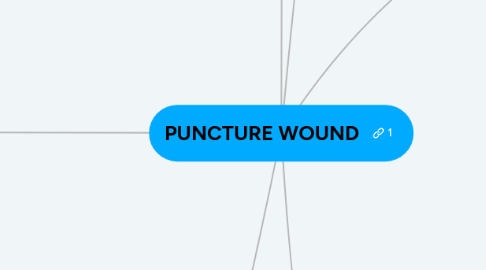
1. Nursing Management
1.1. Medication Administration
1.1.1. Pain Management/Control
1.1.1.1. IV infusion - Morphine/ Dilaudid
1.1.1.2. acetaminophen, hydromorphone and morphine
1.1.2. Insert Peripheral IV
1.1.2.1. Large Bore IV @ TKVO - Potential Fluid Resuscitation (NS/RL)
1.1.2.2. Start infusion of NS or RL; according to hospital policy.
1.1.3. Prophylaxisis antibiotics
1.1.3.1. cefazolin
1.1.3.1.1. fights against gram +/- bacteria
1.1.3.2. vancomycin
1.1.3.2.1. gram + cocci and bacilli ex. Staphylococcus aureus
1.1.3.3. piperciillin
1.1.3.3.1. gram - organisms ex. Pseudomonas aeruginosa
1.2. Safety measures
1.2.1. Patient Id: DOB, Full Name
1.2.2. RCP/Hand hygiene
1.2.3. Oxygen and Suction Equipment Ready
1.2.4. Obtain Informed Consent
1.3. Comfort Measures
1.3.1. Orientation Assessment
1.3.2. Remove any clothing around injury
1.3.3. Provide warm blanket: prevent hypothermia
1.3.4. Emesis bin at bedside
1.4. Wound Care
1.4.1. clean external wound edges with NS
1.4.2. Low pressure irrigation PREVENT mobilization of nail
1.4.3. Immobilize wound surface with gauze/sertile pads
1.5. Documentation
1.5.1. Medication
1.5.1.1. Antibiotic Therapy: Dose, duration & indication
1.5.1.2. PRN medications
1.5.2. Wound care
1.5.2.1. location, type, wound edges, drainage, odor etc.
1.6. Blood Specimen Collection
1.6.1. Draw Bloodwork: FILL IN & CONNECT TO DIAGNOSTIC TESTING
2. OUTCOME
2.1. Discharge Planning
2.1.1. Patient Teaching
2.1.1.1. Medication Administration
2.1.1.1.1. Analgesic
2.1.1.1.2. Stool Softeners
2.1.1.1.3. Blood Thinners
2.1.1.1.4. Past Medications
2.1.1.1.5. Antibiotics
2.1.1.2. Post-op Complication Prevention
2.1.1.3. Wound care/Infection Management
2.1.1.3.1. Signs and Symptoms of Infection
2.1.1.3.2. Excess bleeding
2.1.2. Support Systems
2.1.2.1. Family
2.1.2.2. Friends
2.1.2.3. Support Animal
2.1.3. Follow up Consultation
2.1.3.1. Lab Draws
2.1.3.1.1. PTT/PT/INR
2.1.3.1.2. CBC
2.1.3.2. Suture Removal
2.1.3.3. Imaging
2.1.4. Medical Record/Procedural Review
2.1.4.1. Patient Information
2.1.4.2. Procedure Debrief
3. PATIENT ASSESSMENT
3.1. Patient History
3.1.1. Past Medical History
3.1.1.1. Superficial cuts
3.1.1.2. Hypertension (HTN)
3.1.1.3. Overweight
3.1.1.4. No history of falls
3.1.1.5. High Stress
3.1.2. Demographics
3.1.2.1. White 54 y/o man
3.1.2.2. Construction worker
3.1.2.2.1. Family Financial Provider
3.1.2.3. Lives in a very safe and affluent neighbourhood
3.1.2.4. Part of a westernized culture, born and raised in Canada
3.1.3. Medication History
3.1.3.1. Daily Medications
3.1.3.1.1. Beta Blockers (for management of HTN)
3.1.3.2. Allergic Rx to past medications
3.1.3.2.1. N/A
3.1.3.3. Medications taken prior to admission
3.1.3.3.1. N/A
3.1.3.4. Vaccination History
3.1.3.4.1. Tetanus Booster = UP TO DATE
3.1.3.4.2. Annual Flu vaccine
3.2. Objective Assessment
3.2.1. CHIEF COMPLAINT
3.2.1.1. Puncture wound to epigastric area
3.2.1.1.1. 1-inch, galvanized nail from pneumatic nail gun in epigastric area visible under xyphoid process
3.2.1.1.2. A + O x3, diaphoretic, pale
3.2.1.1.3. Localized swelling, rednessness at injury site
3.2.2. Vital Signs
3.2.2.1. Temperature: 37.2
3.2.2.2. HR: 90 BPM
3.2.2.3. RR: 20 BPM
3.2.2.4. BP: 165/98 mmHg
3.2.2.5. O2 Sat: 96% on RA
3.2.3. BMI: 25.0
3.3. Subjective Assessment
3.3.1. Clinical Manifestations
3.3.1.1. Pale and slightly diaphoretic
3.3.1.2. Alert and conversing
3.3.1.3. Sharp pain of 2/10, not radiating to other areas PQRSTU?
3.4. Continous Monitoring
3.4.1. Neurological Assessment
3.4.1.1. Mental Status: A+OX3
3.4.1.2. Clear Speech
3.4.2. Airway, Breathing, Circulation
3.4.2.1. Continuous Vital Signs
3.4.2.2. Skin Colour: appropriate for ethnic background
3.4.2.3. Temprature: Warm to touch
3.4.3. Pain Intensity
3.4.4. Abdominal Assessment
3.4.4.1. Inspection: masses, colour changes, swelling, enlarged viewns
3.4.4.2. Auscultationg Bowel sounds
3.4.4.3. ,percuss for general tympany, liver span, and splenic dullness.
4. Questions/Concerns/ Patient Understanding
4.1. Ability to participate in care management
4.2. Adresses questions to Nurse
4.3. Can repeat instructions back to nurse with understanding and rationale
5. DIAGNOSTIC TESTING
5.1. Differential Diagnoses
5.1.1. Liver Puncture
5.1.1.1. Comprehensive Metabolic Panel
5.1.1.1.1. LFT (ALT/AST/ALP)
5.1.1.1.2. Bilirubin
5.1.1.1.3. Albumin
5.1.2. Stomach Puncture
5.1.2.1. CT/Ultrasound
5.1.3. Intestinal Puncture
5.1.3.1. CT/Ultrasound
5.1.4. Peritoneal Puncture
5.1.4.1. CT/Ultrasound
5.2. CBC/Electrolytes/Creatinine
5.2.1. INR, PT, aPTT
6. MEDICAL MANAGEMENT
6.1. Pharmacological Management
6.1.1. Antibiotics
6.2. Surgical Intervention
6.2.1. Procedure
6.2.2. Complications
6.2.2.1. Hemorrhage
6.2.2.2. Infection
6.3. Interprofessional Collaboration
6.3.1. Surgeon
6.3.1.1. Perform surgery to repair damaged structures or to remove foreign objects
6.3.2. Physician/Nurse Practitioner
6.3.2.1. Prescribe medications
6.3.2.2. Request blood work
6.3.2.3. Request diagnostic testing
6.3.3. Nurse
6.3.3.1. Perform a trauma assessment
6.3.3.2. Assess the patient for complications (eg. infection)
6.3.3.3. Obtain medical history
6.3.3.4. Obtain vital signs
6.3.4. Radiology Technologist
6.3.4.1. Perform diagnostic imaging Eg. CT scan, ultrasound, and abdominal X-ray to assess injury
6.3.5. Social Worker
6.3.5.1. Provide support through the rehabilitation process
6.3.5.2. Help patient cope with physical changes
6.3.5.3. Assist the patient to maximize independence and autonomy in the various areas of his functioning
6.3.6. Nutritionist/Dietician
6.3.6.1. Assess patient for ability to tolerate regular feedings
6.3.6.2. Prescribe parenteral or enteral nutrition if needed due to trauma
6.3.7. Pharmacist
6.3.7.1. Check and dispense prescribed medications
6.3.8. Physiotherapist
6.3.8.1. Assist with early immobilization and breathing exercises
